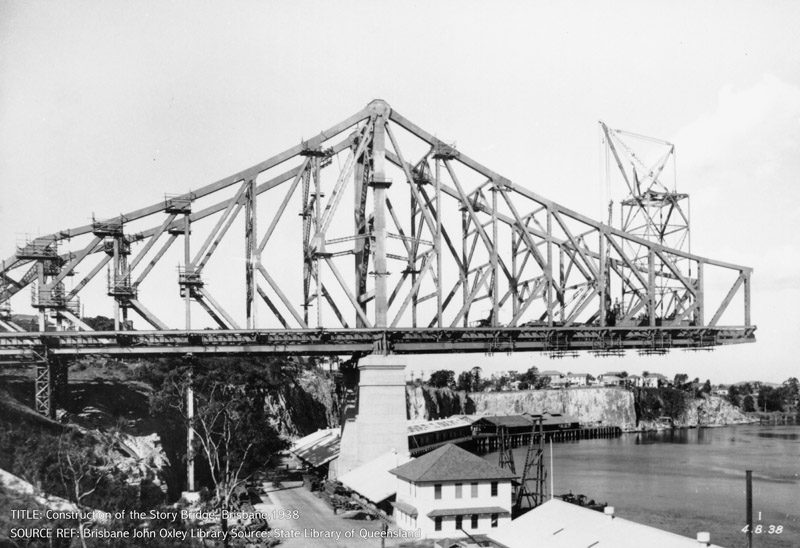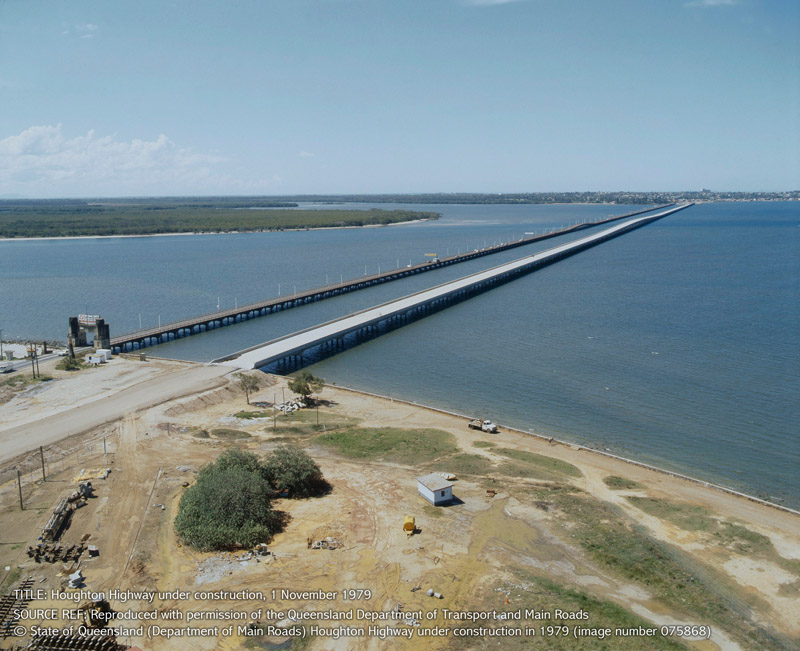Memory Lane – EMU East Wall
Lang Park, Milton, under construction, 24 January 1952
Yugara Country
Castlemaine Street to the left meets Caxton Street which extends across the end of the park with St Brigid’s Catholic Church, Red Hill, on the hill in the distance.
The site of Lang Park was originally the North Brisbane Burial Grounds and was Brisbane’s primary cemetery until 1875. As population grew in the surrounding area, the Paddington Cemeteries Act 1911 enabled the site to be redeveloped as a recreational park. In 1914 it was fenced off and renamed Lang Park after Reverend John Dunmore Lang who assisted early immigrants to Brisbane. Some of the burials were removed to Toowong and South Brisbane Cemeteries and a number of headstones were placed in a small memorial cemetery adjacent to the park and near the small Christ Church.
In the early years, Lang Park was home to a variety of sports including cycling, athletics and soccer.
From 1935 regular soccer matches were played there. In 1950 the Lang Park Police Citizens Youth Club commenced activities such as boxing, wrestling, basketball and gymnastics. From the 1960s, interstate and international Rugby League matches were held including the first State of Origin match in 1980. In 1972 It was the home of the Western Suburbs Panthers and the Brisbane Broncos from 1988. In 1994 the stadium was renamed Suncorp Stadium and in the late 1990s was redeveloped into a rectangular stadium seating 52,500 where soccer, rugby union and rugby league matches are played. Several times a year it becomes a concert venue. The enclosed stands on the sidelines make it one of the best rectangular stadiums in Australia for spectator viewing and atmosphere. Extensive repairs were carried out after the stadium suffered major damage in the 2011 floods.
Story Bridge in the fourth stage of construction, Brisbane, 1938
Yugara Country
Complete deck crane being erected during the fourth stage of the construction of the Story Bridge. The north main pier, main posts and tower traveller are in view. The Story Bridge – built as part of the State Government’s response to the Great Depression – remains one of Queensland’s most iconic landmarks. Ground was broken for the project in 1935, and the cantilever bridge was officially opened on 6 July 1940 by Governor Sir Leslie Orme Wilson.
Public meetings calling for a bridge between northern Brisbane and Kangaroo Point began as early as November 1888. By the 1920s, Brisbane had grown vast but the Victoria Bridge remained the sole inner-city river crossing. Suburbanites claimed that this bridge was ‘congested and unable to carry the traffic’ and that more direct access to the districts of Woolloongabba and Coorparoo was necessary.
The new Queensland Labour Government permitted the establishment of a Bridge Board in 1933 to plan a government-constructed toll bridge at Kangaroo Point, promoted as an employment-generating scheme during the Great Depression. The design for the bridge was completed by Dr John Bradfield, a Brisbane-born engineer who had spent much of his life working in New South Wales.
In 1937, Cabinet decided to name the bridge after John Douglas Story, a public servant and Vice-Chancellor of the University of Queensland.
Finally, after five years and at a cost of £1.6 million, the bridge was completed. The Story Bridge opened on 6 July 1940 to a crowd of 37,000 people. When it first opened, a toll booth was established to assist the State Government with loan repayments. The toll charge for a motor car was sixpence. The presence of American troops in Brisbane during the Second World War helped to pay off the bridge’s costs, and the toll was removed by 1947. The Story Bridge remains an iconic emblem of Brisbane. More than 30 million vehicles now cross the bridge each year.
Houghton Highway under construction – November 1979
Turrbal and Kabi Kabi Country
Investigations during the 1970s indicated that the Hornibrook Highway Bridge was not capable of carrying an increasing volume of traffic and a replacement viaduct was authorized by the Department of Main Roads in 1977. The new bridge was named the Houghton Highway, after Jim Houghton, former Mayor of Redcliffe and Queensland MLA. It was the second bridge to be built across Bramble Bay to connect Redcliffe and Brisbane.
Opened to traffic on 20 December 1979, it consisted of two lanes, a shoulder or ‘breakdown lane’, and a footway, which only ever had minimal use. The intention was to refurbish the Hornibrook Bridge to provide two lanes of northbound traffic while the new bridge would provide two lanes of southbound traffic. As traffic reached the capacity of this bridge a duplication bridge, the Ted Smout Memorial Bridge, was planned and completed in July



